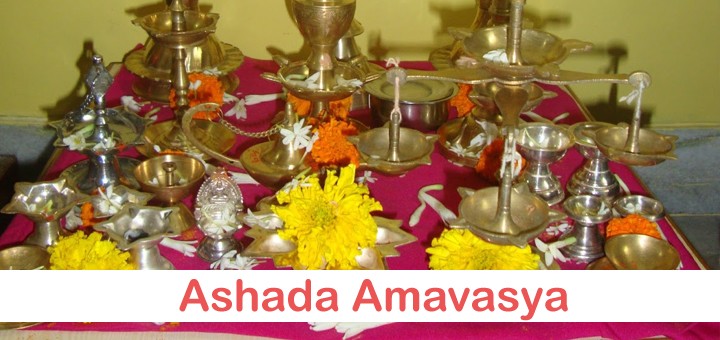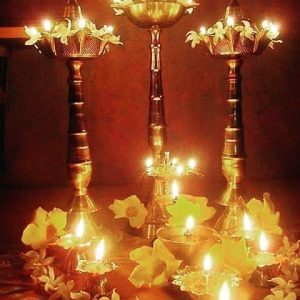Ashada Amavasya
- Ashada Amavasya marks the arrival of the auspicious month of Shravan for Hindus
- Maharastrians celebrate it as Gatari Amavasya
- Kannadiga’s celebrate as Bheemanamavasya
- Telugu people celebrate it as Chukkala Amavasya
- Tamilians as Adi Amavasya
- Keralites celebrate it as Karkidaka Vavubali
The month of Aadi/ Ashadam is considered highly auspicious, it is said that it is the time when divine forces bless the Earth with grace and answer your prayers. Offering tarpanam to ancestors on Aadi/Ashdam Amavasaya helps their souls attain Moksha (salvation) and also confers their blessings upon self.

Also Read: Rituals for Niraputhari celebrations start in Sabarimala

Also Read: Pavitrotsavam and Sri Andal Tiruvadippudi Utsavams Commence in Tirupathi
Ashada Amavasya (New Moon day) is around the corner, this year it falls on Sunday, 23 July, lets have a look why this Amavasaya is significant for South Indians but is celebrated differently across states. Ashada Amavasya is marks the arrival of the auspicious month of Shravan for Hindu’s. Maharastrians celebrate it as Gatari Amavasya, Kannadiga’s celebrate as Bheemanamavasya, Telugu people celebrate it as Chukkala Amavasya, Tamilians as Adi Amavasya and Keralites celebrate it as Karkidaka Vavubali.
Gatari Amavasya is an important day for Maharastrian’s, though it is primarily a Tarpan giving day for the elders, it is also celebrated as the onset of Shravan. As during many Hindu’s abstain from eating non-vegetarian food and alcohol for the next 40 days hence they celebrate this day with lot food and drinks.
Ashada’s new moon day is celebrated as Bheemana Amavasya in Karnataka. On Bheemana Amavasya Shiva and Parvathi are worshipped in the form of Bheemeswara. Bheemeswara is prayed to as the two or four clay structures and a yellow thread tied around them. Bheemanamavasya is also known by called as Gandana Puje. This pooja is done women for the well being of men in the family. Married women pray for their husband’s longevity and prosperity while the unmarried girls pray to get a good husband. It is one of the unique festivals in Karnataka.
According to the legend of Bheemana Amavasya, once there lived a Brahmin couple who wanted to go on Kashi yatra but could not go due to an unmarried daughter. They didn’t want to take her on the long, arduous journey, so they decide to leave her with her elder brother and his wife. The Brahmin couple leaves for Kashi yatra but they do not come back for a long time. And the greedy elder brother and his wife decide to marry her off to a dead prince in exchange for wealth. After the marriage ceremony, the King, the girl (bride) along with soldiers go to bury the prince on the banks of Bhagirathi River. While they are doing the last rituals, it starts raining and everyone begins to run away. The king invites his daughter-in-law to go back to palace, but she decides to stay with the dead prince. The King leaves but she remembers about this Amavasya Vrata which her parents used to perform. So, the young bride takes the mud and creates two like structures (Kalikamba lamps) and starts praying. A young couple travelling see comes and ask her about this Vrata. The young bride tells about them the story and seeks their blessing, unknowingly the young couple bless her ‘Dheerga Sumangali Bhava’ which means, “May you live a long life with your husband” and asks her to wake the dead prince. The girls realises that it is the Shiva and Parvathi who blessed her. Hence, even to this day married women perform this pooja every year for 9 years after marriage.
Ashada Amavasya or Chukkala Amavasya as called in Andhra is is a very auspicious day in the month of Ashadha. On this day like during Deepavali, people lite diyas’ around the house. According to the legend as it is the twilight in the other world, it is believed that these lights not only help the elders to travel with the help of these lights but also that these lights will cleanse the atmosphere in around the house before the onset of shravan.
Tamilians and Keralites take the opportunity to of this Amavasya day to remember their elders by giving them Tarpan on this day. Adi Amavasya for Tamilians is the most auspicious day of the month for them, they do special pooja’s on this day. Keralites also believe that celebrating as Karkidaka Vavubali day will bring them longevity and prosperity.
And in many parts of South India it is also celebrated as the festival of brothers like the Raksha Bandhan of North. Brother visit the sisters house for lunch and bless the sister for the prosperity.











